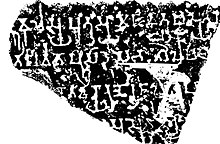
Summary
The Mountain Temple inscription was found near Mathura, India. It is on a broken slab, and now housed at the Indian Museum, Kolkata.[1][2]
| Mountain Temple inscription | |
|---|---|
 Ancient Sanskrit inscription Indian Museum, Kolkata | |
| Writing | Sanskrit |
| Created | ~ 1st Century CE |
| Place | Mathura, Uttar Pradesh |
| Present location | Indian Museum, Kolkata |
| Identification | NS 6482 |
The Mountain Temple inscription makes an early mention of Hindu and Jain temple architecture, where its shape is described to be like a mountain and accompanied with an assembly hall (sabha). The inscription's wording and arrangement, state Luders and Janert, closely resembles the Mora Well inscription, now in Mathura museum. Both describe a donation of a stone temple, halls and slabs; however, the Mora Well inscription is more detailed and mentions pratima. The Rajula in line 3 of the Mountain Temple inscription is likely the Northern Satraps Great Satrap Rajuvula, found in Mathura lion capital.[2]
The Mountain Temple inscription lacks a date. The similar Mora Well Inscription is dated to the early decades of the 1st-century CE and is related to early Vaishnavism: the Mora Well inscription mentions stone shrines dedicated to five Vrishni heroes.[3]
Inscription edit
The discovered inscription is incomplete, in not quite correct Sanskrit.[2] It reads:[1]
1. . . . uvulasya putrasya mahaksatrapasya so ...
2. . . . ti parvato prasade(or do) sabha silapata ...
3. . . . taviryo rane rajulas ca pi[ta] ...
4. . . . sasyedam arca ...
Translation edit
Sonya Quintanilla translates it as,[1]
. . . of the mahaksatrapasya So(dasa), son of (Raj)uvula . . .
a temple like a mountain, an assembly hall, stone slabs...
whose heroism in battle, and (his) father Rajula . . .
this . . . of his is adored.
References edit
- ^ a b c Sonya Rhie Quintanilla (2007). History of Early Stone Sculpture at Mathura: Ca. 150 BCE - 100 CE. BRILL Academic. p. 260. ISBN 90-04-15537-6.
- ^ a b c Heinrich Lüders and Klaus Ludwig Janert (1961), Mathurā inscriptions, Göttingen : Vandenhoeck & Ruprecht, OCLC 717966622, pages 203-204, 154, image on page 318
- ^ Doris Srinivasan (1997). Many Heads, Arms, and Eyes: Origin, Meaning, and Form of Multiplicity in Indian Art. BRILL Academic. pp. 211–214, 308-311 with footnotes. ISBN 90-04-10758-4.



